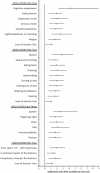Why do patients with Parkinson's disease fall? A cross-sectional analysis of possible causes of falls
- PMID: 28409181
- PMCID: PMC5388183
- DOI: 10.1038/npjparkd.2015.11
Why do patients with Parkinson's disease fall? A cross-sectional analysis of possible causes of falls
Abstract
Background: Falls in Parkinson's disease (PD) are associated with significant injury, disability, hospitalization, and reduced quality of life.
Aims: To identify modifiable medical causes of falls in a cohort of PD patients.
Methods: Eighty seven PD patients were interviewed and examined using validated scales assessing motor and nonmotor aspects of PD, comorbidities and medication use. The frequency of falls in the last month was the primary outcome measure. Falls were hypothesized to be associated with increasing age, advanced motor severity, particularly axial features (e.g., freezing and postural instability), and dyskinesia. Nonmotor features hypothesized to be associated with falls included; cognitive impairment, psychosis, sleep disorders, cardiovascular dysfunction, and ophthalmological and medical comorbidities.
Results: Fallers had longer disease duration, higher Levodopa-equivalent doses, greater 'On' time with dyskinesia (all P < 0.005), and higher scores on some Movement Disorder Society-Unified Parkinson's Disease Rating Scale items, particularly axial scores. However, patients with falls did not differ from non-fallers in age or overall motor UPDRS scores. Severity of psychosis, executive cognitive impairment, autonomic (particularly cardiovascular) dysfunction and sleep disturbances (particularly REM sleep behavioral disorder) were significantly associated with falls (all P < 0.005). Fallers more frequently reported use of antidepressants (both tricyclics and SSRIs) and neuroleptics (P < 0.001), but not hypnotics. There was no difference in medical comorbidities, ophthalmological assessments, fatigue, and apathy scores between the groups. In logistic regression analysis, cardiovascular dysfunction, antidepressant use, and REM sleep behavioral disorder were significantly associated with falls.
Conclusions: The causes of falls in PD are multifactorial and extend beyond motor impairment and dyskinesia; addressing these in patients already treated with dopaminergic medications has the potential to improve this important complication of PD.
Conflict of interest statement
Competing Interests The authors declare no conflict of interest.
Figures
References
-
- Kerr GK, Worringham CJ, Cole MH, Lacherez PF, Wood JM, Silburn PA. Predictors of future falls in Parkinson disease. Neurology 2010; 75: 116–124. - PubMed
-
- Bloem BR, Grimbergen YA, Cramer M, Willemsen M, Zwinderman AH. Prospective assessment of falls in Parkinson's disease. J Neurol 2001; 248: 950–958. - PubMed
Grants and funding
LinkOut - more resources
Full Text Sources
Other Literature Sources
Medical


